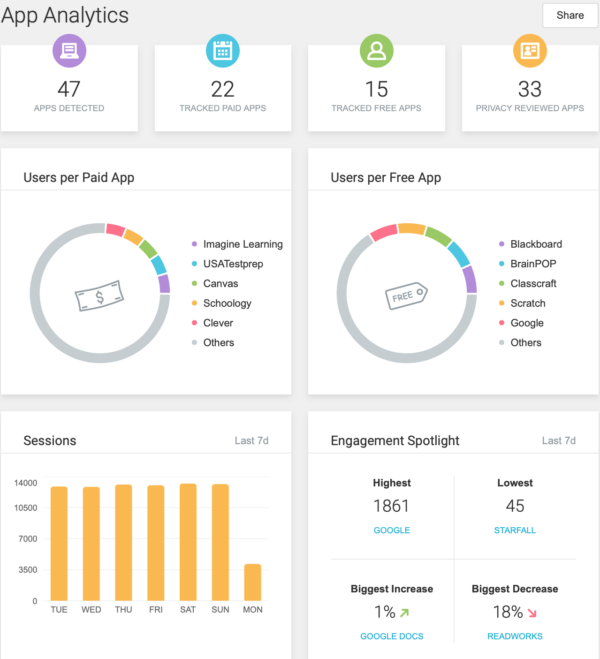学校对远程学习不了解的事情
随着全球 90% 名学生离开实体课堂,资金已重新分配,并迅速制定了支持远程学习的计划。学生家中拥有的学校设备比以往任何时候都多。教师们开始远程授课——有些是在州或学区的指导下,有些是自己授课。学生们也登录网络在家学习。
但学校真的知道谁在做什么吗?
(如果不这样做,他们如何确保远程学习的有效性和安全性?)
用户的活动比以往任何时候都更可能成为学区管理人员的黑洞——而就在这时,他们比以往任何时候都更需要数据来在这个新世界中做出决策,并向学校董事会、家长和社区证明资金和资源得到有效利用,以让学生参与远程教学。
您知道有关学校远程学习的这些问题的答案吗?
- 您的老师是否使用未经审查的视频和聊天工具?
在关闭期间谁没有使用过您的 LMS? - 您添加的哪些新工具真正被采用?
- 哪些学生参与了远程学习?哪些学生没有参与?
- 上个月使用了哪些工具而本月没有使用,反之亦然?
- 教师是否实施了违反学生数据隐私政策的免费工具?
- 教师是否需要额外培训才能有效地使用新的数字工具?
- 哪些课程是活跃的,哪些课程是不活跃的?

数据比以往任何时候都重要,但由于设备和用户不仅分散在一个地区,而且分散在整个城镇,因此整体的可视性可能更难实现。
和 光速数字洞察™,学校获得了有关远程学习的使用、活动和有效性所需的答案。
跨应用程序、应用程序和网站以及跨操作系统的活动数据被汇总在一起,以提供学校需要的信息:
- 提高投资回报率 – 查看正在使用的内容、未充分利用的内容以及哪些许可证是多余的或不必要的
- 提高采用率 – 深入了解应用程序或工具以及学校、班级或用户的采用和参与情况
- 确保学生数据隐私—— 发现未经审查且可能违反数据安全和隐私政策的“流氓”应用程序
- 让远程学习安全有效—— 确保活动符合指导方针;确保工具安全;确保所有学习者和教育工作者都参与其中
Lightspeed Analytics 易于部署(从任何地方),学校将快速获得所需的信息,以做出更明智的、数据驱动的决策,以改进围绕远程学习工具和技术的计划。
如果说新冠病毒教会了我们什么,那就是学校需要制定远程学习计划。要使这些计划有效,就需要以数据为指导。

